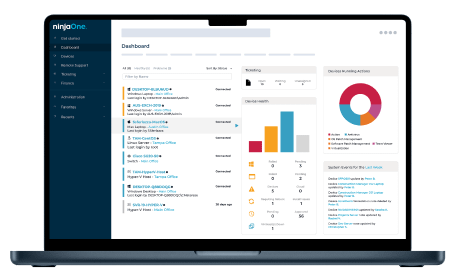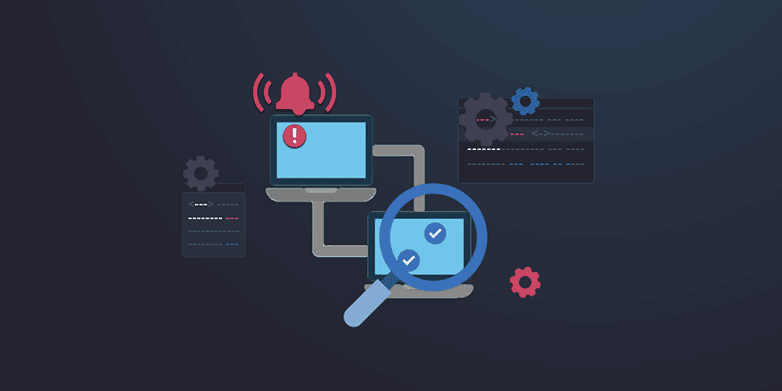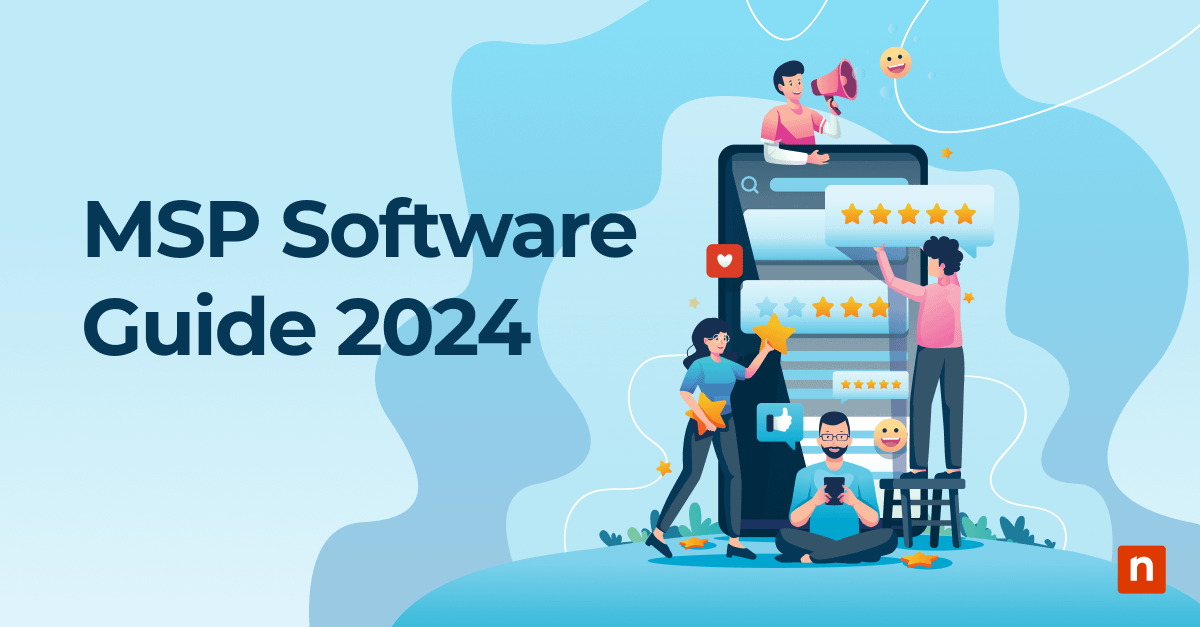Få bedre kontrol over Linux Patch Management
Identificer og afhjælp automatisk sårbarheder på dine Linux-, macOS- og Windows-slutpunkter for at minimere din angrebsflade.
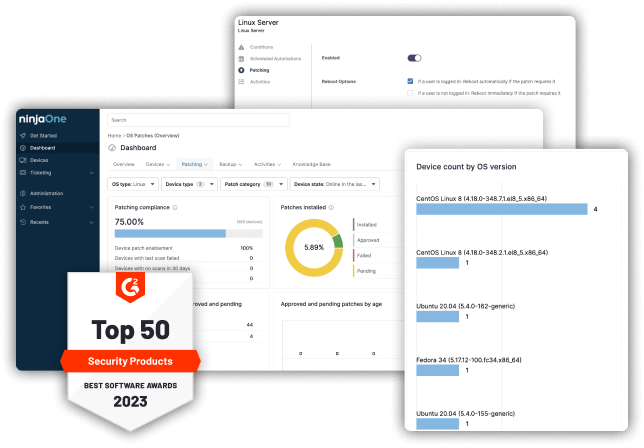
Styrk sikkerheden med forbedret patch-compliance
90% hurtigere patching
Automatiser hvert trin i patching-processen, så dine teknikere kan fokusere på support og strategiske projekter.
Få synlighed og kontrol
Få fuld indsigt i og kontrol over patch-skemaer, genstartsadfærd og automatiseret godkendelse for at sikre, at dine endpoints altid er sikre.
Sådan burde Linux-patching være
Konsistent patchning er et kritisk skridt i retning af at opretholde en stærk sikkerhedsposition. NinjaOne giver klar synlighed over din organisations overordnede patch-status og muliggør hurtigere identifikation og afhjælpning af softwaresårbarheder.
Kraftfuldt, intuitivt patch-dashboard
Se hurtigt og nemt OS-patchstatus for alle Windows-, macOS- og Linux-slutpunkter, så du kan træffe hurtigere og mere informerede beslutninger.
Linux OS Patching
Identificer kendte sårbarheder i Linux-operativsystemer, og implementer patches for at minimere din angrebsflade.
Patching af Linux-applikationer
Patch enhver applikation, der er tilgængelig via APT, DNF eller YUM i det repository, der er konfigureret på dit endpoint.
Automatisering af Linux-patches
Patch endpoints 90% hurtigere med zero-touch patch-identifikation, godkendelse, implementering og genstart.
Speed Remediation Efforts
Giv øjeblikkeligt teknikere besked via e-mail, SMS, Slack og andre kanaler om ventende eller mislykkede patches for hurtigere afhjælpning.
Værktøjer til afhjælpning
Patch nemt dine lokale, eksterne og hybride slutpunkter, uanset placering eller netværk.
Forebyggende godkendelse af plastre
Forebyggende godkendelse af plastre
Godkend patches på forhånd for at forhindre zero days, og bloker automatisk problematiske patches for serviceafbrydelser.
Netværksløs Wake-for-Patch
Forbedre succesraten for patches ved at vække alle enheder før patchescanninger og patchopdateringer uden behov for wake-on-LAN.
Rapportering af Linux-patches
Rapporter om patch compliance-status, mislykkede patch-implementeringer og kendte endpoint-sårbarheder med et klik på en knap.
Her er, hvad kunderne siger om os
Hvor RMM’er burde være. Ninjas patch management-funktion slår alle andre RMM’er med flere længder, og brugervenligheden er, hvad alle andre RMM-produkter håber på.
MATTHEW ANCIAUX
LEDENDE PARTNER,
MONARCHY IT LLC
Bring automatisering til IT-drift. Patch management i Windows og tredjeparts-patching har sparet os for mange mandetimer i forhold til vores almindelige patchning. NinjaOne har hjulpet os med at automatisere vores team.
CHRIS HESSLER
IT SUPPORT,
CROSSROAD CHURCH
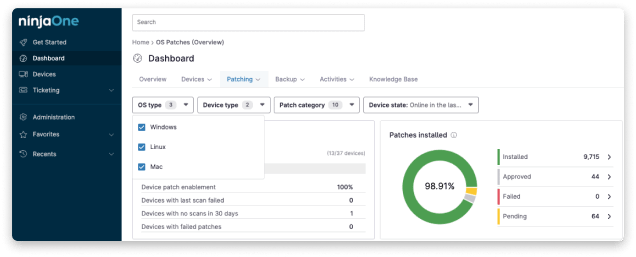
Forenklet, ensartet patching til dine Linux-slutpunkter
Opret nemt meget tilpassede Linux-patching-politikker, herunder genstartsmuligheder, scanningsskema og meget mere, så de bedst muligt opfylder dine krav.
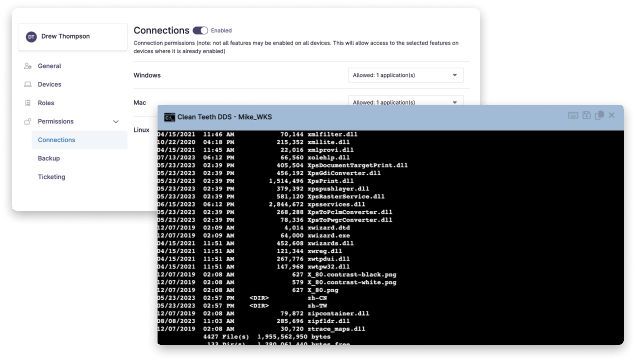
Få et klart overblik over dine nuværende Linux-distributioner
NinjaOne giver et klart indblik i de Linux-distributioner, der i øjeblikket understøtter din IT-portefølje. Tag hurtigere og mere informerede beslutninger for bedst muligt at understøtte dine brugere og opretholde en stærk sikkerhedsposition.

Hurtig patchning med kraftfulde automatiseringsfunktioner
Udnyt NinjaOne-automatisering til at reducere Linux-patchningstiden med op til 90% og reducere risikoen for menneskelige fejl.

Download 2023 Patch Management Buyer's Guide (på engelsk)
Download denne guide til indkøb af patch management, og se, hvorfor NinjaOne Patch Management konsekvent er vurderet som nr. 1.
Opdateringer og ressourcer
Linux Patch Management FAQ
Hvad er processen for håndtering af patches i Linux?
Der er flere trin i patching, men hvis du vil forenkle disse trin for Linux-enheder, kan du kombinere dem i tre kritiske trin:
1) Overvågning og scanning af slutpunkter
2) Oprettelse af patching-politikker
3) Implementering af patches
Ligesom Windows patch management er Linux patch management processen med at sikre og opdatere operativsystemet. Ved at distribuere patches til alle dine endpoints kan du holde dine Linux-enheder sikre og opdaterede med alle de nyeste funktioner.
Hvad er nogle af udfordringerne ved patch management til Linux?
Selv de dygtigste IT-afdelinger og MSP’er løber ofte ind i patch management-problemer. Selvom du måske ikke kan løse alle disse udfordringer med Linux-patching på én gang, er det første skridt til at skabe en sikrere og mere effektiv patch management-proces at være opmærksom på, at de findes.
- Afbrydelser af arbejdsgange
Når man patcher slutpunkter, der påvirker store grupper af mennesker, som f.eks. Linux-servere, skal IT-teams planlægge patch-udrulningerne, så de sker uden for spidsbelastningstimerne. Ved at planlægge på denne måde kan organisationer undgå at forstyrre arbejdsgange med normale patchprocesser, såsom genstart.Selv de dygtigste IT-afdelinger og MSP’er løber ofte ind i patch management-problemer. Selvom du måske ikke kan løse alle disse udfordringer med Linux-patching på én gang, er det første skridt til at skabe en sikrere og mere effektiv patch management-proces at være opmærksom på, at de findes.- Afbrydelser af arbejdsgange
Når man patcher slutpunkter, der påvirker store grupper af mennesker, som f.eks. Linux-servere, skal IT-teams planlægge patch-udrulningerne, så de sker uden for spidsbelastningstimerne. Ved at planlægge på denne måde kan organisationer undgå at forstyrre arbejdsgange med normale patchprocesser, såsom genstart.
- Ufuldkomne patches
Desværre er patches ikke perfekte. Selv de patches, der gennemgår strenge sandkassetests, ender nogle gange med at skabe fejl, der skal rettes. En måde at sikre, at en patch fungerer, som den skal, er at installere den på en lille gruppe af dine Linux-enheder i stedet for på hele din IT-infrastruktur. Hvis den lille gruppe ikke har nogen negative effekter af opdateringen efter en vis tidsperiode, er det normalt sikkert at installere patchen på resten af Linux-enhederne.
- Mængden af patches
Det tager tid at patche alle Linux-enheder på et netværk, især hvis en organisation ikke bruger automatisering, og det er komplekst arbejde. Mens små virksomheder måske ikke har et problem, kæmper store organisationer og virksomheder ofte med den enorme mængde patches, der skal implementeres.
- Manuelle fejl
Menneskelige fejl og manuelle fejl sker, og bortset fra automatisering er der ingen måde at undgå dem på. Konsekvenserne af upatchet software er ofte alvorlige, og alt, hvad en cyberkriminel behøver for at få succes, er en glemt og upatchet Linux-server eller endpoint.
Hvordan patcher man Linux-enheder?
Patchningsprocessen for Linux-enheder vil variere afhængigt af den patchningsløsning og de strategier, du bruger. Med NinjaOne patcher du Linux-servere og -enheder ligesom alle andre slutpunkter. Takket være NinjaOnes klare og intuitive brugergrænseflade kan du opsætte og planlægge automatiserede patching-politikker og udrulninger til alle dine Linux-enheder med blot et par klik.
Hvad er bedste praksis for patch management i Linux?
- Implementer Linux-patches ASAP
Selvom det er fristende at udskyde patching til et senere tidspunkt, bør IT-teams prioritere patch management og implementere Linux-patches så hurtigt som muligt. Jo længere du venter med at implementere kritiske patches, jo mere tid har cyberkriminelle til at skade dit IT-miljø og din organisation som helhed.
- Hold dig opdateret på leverandørernes patch-udgivelser
Selvom din patch management-software bør downloade leverandørpatches automatisk, er det nyttigt for administratorer at holde sig opdateret om de seneste udgivelser. Ved at undersøge de nye Linux-opdateringer kan administratorer lære, hvilke sårbarheder de skal holde øje med, og hvordan de bruger nye og opdaterede funktioner.
- Mindsk risikoen for patchfejl
Grundig patch-testning er en vigtig del af enhver vellykket patch management-strategi, men hvis en fejl slipper igennem, bør administratorer konfigurere deres patch-software til at advare dem, når der opstår patch-fejl. Med disse advarsler på plads kan IT-teams enten stoppe opdateringer eller hurtigt brainstorme andre løsninger til at løse patchfejl.
- Test og auditér alle Linux-patches
Desværre er patches ikke altid perfekte, så organisationer bør teste og revidere alle Linux-patches, før de implementeres på alle deres enheder. En måde at håndtere dette på er at oprette en lille kontrolgruppe bestående af Linux-systemer og kun distribuere patches til denne gruppe. Hvis systemerne fungerer, som de skal, efter en bestemt tidsperiode, er det sikkert at distribuere patchen til resten af systemerne.
- Automatiser Linux patch management
Der er mange fordele ved automatiseret patch management, som en organisation får, når de lader manuel patchning ligge i fortiden, såsom øget effektivitet og produktivitet. Automatisering er den bedste måde at gøre Linux patch management enklere, hurtigere, nemmere og mere effektiv. På grund af det stigende antal enheder og patches i forhold til det faldende antal it-medarbejdere er automatiseret patching ikke længere en luksus, men en nødvendighed. og mere effektiv. På grund af det stigende antal enheder og patches i forhold til det faldende antal it-medarbejdere er automatiseret patching ikke længere en luksus, men en nødvendighed.
Er du klar til at blive en IT-Ninja?
Lær, hvordan NinjaOne kan hjælpe dig med at forenkle enhedshåndtering.
